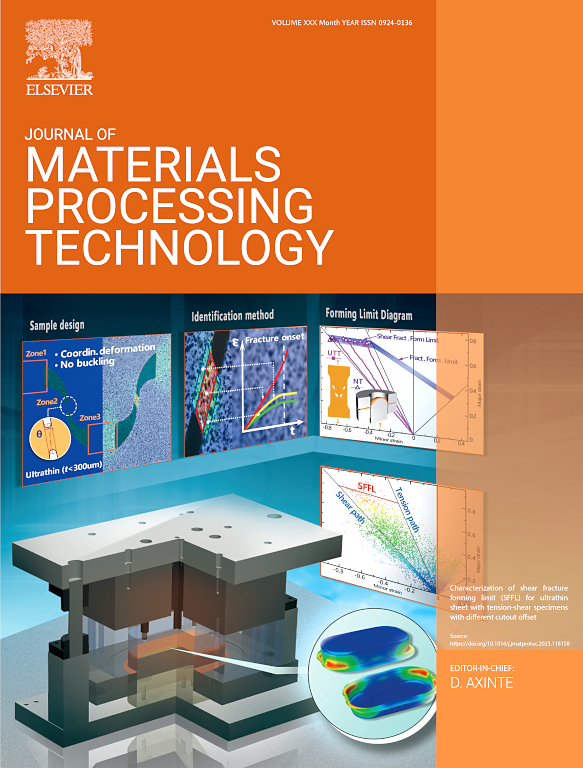添加铝对高强钢t形接头焊剂带缩弧焊组织和力学性能的影响
IF 6.7
2区 材料科学
Q1 ENGINEERING, INDUSTRIAL
Journal of Materials Processing Technology
Pub Date : 2025-05-21
DOI:10.1016/j.jmatprotec.2025.118908
引用次数: 0
摘要
在轻量化制造的背景下,高强度低合金(HSLA)钢t形接头已被广泛应用于先进设备的关键部件中。精确控制合金元素以协同提高HSLA接头的强度和韧性仍然是扩大其应用的关键挑战。铝(Al)是影响HSLA钢组织特征的主要合金元素之一,其含量和引入方式的不同均表现出显著的冶金调节作用。然而,传统焊接工艺对Al的调节存在固有的局限性,包括对元素分布的时空控制不足和工艺效率的限制,而对HSLA接头中Al复杂的“工艺-成分-性能”关系的定量研究仍然很少。为了解决这些挑战,本研究提出了一种创新的原位动态铝调节方法,该方法通过助焊剂带收缩电弧(FBCA)焊接。系统研究了助焊剂带Al含量(0 ~ 0.92 wt%)对HSLA接头热影响区(HAZ)和焊接区(WZ)组织演变和力学性能的影响。结果表明:Al的加入对Q960钢t形接头具有显著的协同调节作用,焊接区和热影响区的平均晶粒尺寸分别细化了17 %和21 %;随着Al含量的增加,焊接区和热影响区的平均硬度提高了35 %。拉伸强度达到955.7 MPa(0.18 wt% Al)和1044 MPa(0.92 wt% Al),最大提高23.5% %。焊接区冲击韧性略有提高,热影响区韧性从94.13 J下降到65.77 J。综合显微结构表征(光学显微镜、能量色散光谱仪、电子背散射衍射)揭示了不同的al调控机制:在焊接区,细小的Al2O3颗粒(<1 μm)诱导针状铁素体形成,在不影响韧性的情况下提高强度。相反,热影响区细化源于电弧收缩引起的温度梯度调制,这促进了低角度晶界积累,增加了位错密度,最终通过提高应变能来降低韧性。本研究为焊接过程中原位元素调节提供了新的见解,阐明了Al对HSLA接头性能的协同作用机制,为HSLA接头中复杂多元素相互作用的定量研究提供了理论基础。本文章由计算机程序翻译,如有差异,请以英文原文为准。
Effect of aluminum addition on the microstructure and mechanical properties of high-strength steel T-joints in flux bands constricting arc welding
In the context of lightweight manufacturing, High-Strength Low-Alloy (HSLA) steel T-joints have been widely adopted in critical components of advanced equipment. The precise control of alloying elements to synergistically enhance the strength and toughness of HSLA joints remains a pivotal challenge for expanding their applications. Aluminum (Al), recognized as one of the most influential alloying elements affecting the microstructural characteristics of HSLA steels, demonstrates significant metallurgical regulation effects dependent on its content and introduction method. However, conventional welding processes suffer from inherent limitations in Al regulation, including insufficient spatiotemporal control over elemental distribution and restricted process efficiency, while quantitative studies on the complex "process-composition-property" relationships of Al in HSLA joints remain scarce. To address these challenges, this study proposes an innovative in-situ dynamic Al regulation approach via Flux Bands Constricting Arc (FBCA) welding. The effects of Al content (0–0.92 wt%) in flux bands on the microstructural evolution and mechanical properties of HSLA joints including heat-affected zone (HAZ) and welding zone (WZ) were systematically investigated. Results demonstrate that Al addition achieves remarkable synergistic regulation on Q960 steel T-joints: average grain sizes in the welding zone and heat-affected zone were refined by 17 % and 21 %, respectively. With increasing Al content, the average hardness of welding zone and heat-affected zone increased by 35 %. Tensile strength reached 955.7 MPa (0.18 wt% Al) and 1044 MPa (0.92 wt% Al), representing a maximum enhancement of 23.5 %. While welding zone impact toughness slightly improved, heat-affected zone toughness decreased from 94.13 J to 65.77 J. Comprehensive microstructural characterization (Optical Microscope, Energy Dispersive Spectrometer, Electron Back Scatter Diffraction) revealed distinct Al-regulated mechanisms: In the welding zone, fine Al2O3 particles (<1 μm) induced acicular ferrite formation, enhancing strength without compromising toughness. In contrast, heat-affected zone refinement originated from arc constriction-induced temperature gradient modulation, which promoted low-angle grain boundary accumulation and increased dislocation density, ultimately reducing toughness through elevated strain energy storage. This work provides novel insights into in-situ elemental regulation during welding and elucidates the synergistic mechanisms of Al on HSLA joint performance, offering theoretical foundations for quantitative studies on complex multi-element interactions in HSLA joints.
求助全文
通过发布文献求助,成功后即可免费获取论文全文。
去求助
来源期刊

Journal of Materials Processing Technology
工程技术-材料科学:综合
CiteScore
12.60
自引率
4.80%
发文量
403
审稿时长
29 days
期刊介绍:
The Journal of Materials Processing Technology covers the processing techniques used in manufacturing components from metals and other materials. The journal aims to publish full research papers of original, significant and rigorous work and so to contribute to increased production efficiency and improved component performance.
Areas of interest to the journal include:
• Casting, forming and machining
• Additive processing and joining technologies
• The evolution of material properties under the specific conditions met in manufacturing processes
• Surface engineering when it relates specifically to a manufacturing process
• Design and behavior of equipment and tools.
 求助内容:
求助内容: 应助结果提醒方式:
应助结果提醒方式:


